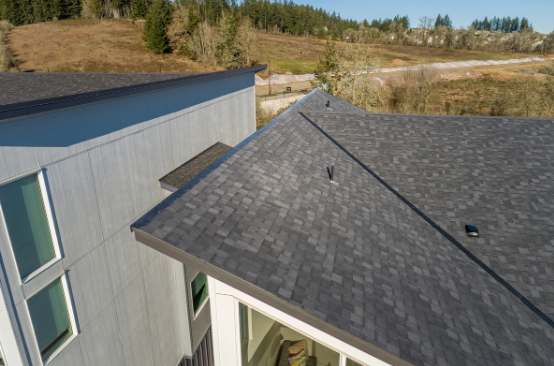Shingle roofs provide excellent protection for your home, but they are also vulnerable to algae and mold growth, especially in areas with high humidity and moisture. The presence of algae and mold can not only affect the aesthetic appeal of your roof but also potentially reduce its lifespan. Fortunately, with proper maintenance and care, you can prevent these issues and keep your roof looking great for years to come. Here’s a comprehensive guide on how to prevent algae and mold on shingle roofs.
1. Install Zinc or Copper Strips
One of the most effective ways to prevent algae growth on your shingle roof is by installing zinc or copper strips near the ridge. These metals naturally release ions when exposed to rainwater, which helps inhibit the growth of algae and mold. The strips slowly release these ions over time, washing down the roof and preventing the accumulation of algae and mold. Zinc and copper strips are relatively inexpensive and can be installed by professionals during a roof replacement or maintenance service.
2. Keep Your Gutters Clean and Functional
Clogged gutters are a common contributor to roof mold and algae growth. When gutters are clogged, water can pool around the roofline and create an ideal environment for algae and mold to thrive. Regularly cleaning your gutters ensures that water flows freely and does not accumulate on your roof. Make sure to inspect your gutters for damage and repair any issues promptly. Keeping your gutters in good condition will not only help with algae prevention but also protect your roof from water damage.
3. Trim Overhanging Trees
Trees that overhang your roof can contribute to moisture retention, which is a breeding ground for algae and mold. Limbs that shade your roof and block sunlight prevent your shingles from drying properly after rainfall. This constant moisture can encourage algae and mold to grow on your roof. To prevent this, trim any overhanging branches to allow sunlight to reach your roof and dry it out more effectively. Trimming trees also reduces the amount of leaves and debris that can accumulate on your roof, further helping to prevent moisture buildup.
4. Regular Roof Inspections
Performing regular roof inspections is an essential part of roof maintenance and helps prevent the growth of algae and mold. Check your roof for any signs of algae, moss, or mold buildup. Early detection allows for prompt cleaning and treatment, which can prevent long-term damage. Look for dark streaks or discoloration, as these are often signs of algae growth. If you’re unsure how to perform a roof inspection, consider hiring a professional roofing contractor to do it for you. Regular inspections will help maintain the health and integrity of your roof.
5. Clean Your Roof Regularly
Cleaning your roof is one of the most proactive ways to prevent algae and mold growth. Using a mixture of water and a gentle cleaning solution, you can remove algae, moss, and mold before they have a chance to spread. Be sure to use a soft brush or a low-pressure washer to avoid damaging your shingles. High-pressure washing can loosen the granules on the shingles, potentially causing more harm than good. It’s best to hire a professional roofing service for this task, as they have the right equipment and knowledge to clean your roof safely and effectively.
6. Apply a Roof Treatment
There are various roof treatments available that can help protect your shingles from algae and mold. These treatments often contain antimicrobial agents that can kill algae and mold spores and prevent them from returning. Some treatments are applied directly to the roof’s surface, while others may be applied as part of a cleaning process. It’s important to choose a roof treatment that is compatible with your roofing material and consult with a professional to ensure proper application.
7. Ensure Proper Ventilation in Your Attic
Poor attic ventilation can contribute to the buildup of moisture on your roof. When warm, moist air from your attic is trapped under your roof, it can lead to condensation that promotes mold growth on shingles. To prevent this, ensure that your attic is properly ventilated. Installing vents in your attic or soffit can help regulate airflow and reduce the risk of moisture accumulation on your roof. Proper attic ventilation not only helps prevent algae and mold but also contributes to better energy efficiency in your home.
Conclusion
Preventing algae and mold on your shingle roof is essential to maintaining its appearance and prolonging its lifespan. By installing zinc or copper strips, keeping gutters clean, trimming trees, performing regular roof inspections, cleaning your roof, applying roof treatments, and ensuring proper attic ventilation, you can minimize the risk of algae and mold growth. If you’re unsure about how to maintain your roof or notice any early signs of algae or mold, don’t hesitate to contact a professional roofing contractor for assistance.
If you’re dealing with algae or mold on your roof or want to prevent it from happening, contact our expert roofing team today. We specialize in roof maintenance, cleaning, and repairs to keep your home protected. Call us now to schedule a consultation and keep your roof in top condition!
This post was written by a professional at NextDoor Exterior Solutions. Looking for reliable roofing contractors in Clearwater, FL and its surrounding areas? Look no further than NextDoor Exterior Solutions! Our experienced team of roofers is dedicated to providing shingle roofing Palmetto fl. Whether you need roof repair, replacement, or installation, we’ve got you covered. Plus, as a solar energy company near you, we can even help you save money on your energy bills with our expert solar panel installation services. The mission and values of our company allow us to always demonstrate the full potential of our professionalism. You can rely on us for quality. Don’t settle for subpar roofing services – choose NextDoor Exterior Solutions and experience the difference. Contact us today!

